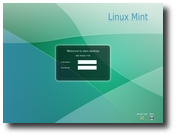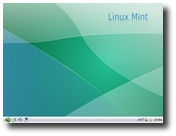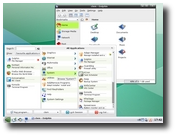Linux Mint is one of the most elegant, good looking and comfortable Linux distributions around. What makes this distribution so popular? It's based on the very popular Ubuntu Linux and it tries to be exactly how you want it to be. I wanted to meet the main developer, Clement Lefebvre, in order to find out some interesting aspects and secrets about his project. Please enjoy this nice interview.
M. Nestor, Softpedia: Hello! Please introduce yourself. Who are you? How old are you? What you do for a living?
Clement Lefebvre: Hi Marius. My name is Clement Lefebvre, I'm 29 and I work in a telecom company as a Java developer.
M. Nestor, Softpedia: Please tell our users, especially the ones that don't know, what is Linux Mint and what benefits can it bring to them.
Clement Lefebvre: Linux Mint is an operating system which can replace Microsoft Windows. It can also be installed on the same computer as Windows and the user can choose between the 2 systems at startup. Technically, Linux Mint is a GNU/Linux distribution and it is based on another one called Ubuntu. Compared to Windows, Linux Mint (and Linux in general) has a lot of advantages.
1. It's 100% free; 2. It comes with support for multimedia codecs and has software already installed for all basic needs (office suite, mail, web etc..); 3. There are no viruses under Linux; 4. The filesystem doesn't need to be defragged, the registry doesn't need to be cleaned... users do not need to do regular maintenance tasks like they do in Windows; 5. It doesn't take as much resources, especially compared to Windows Vista; 6. Everything is configurable; 7. It comes as a LiveCD so you can run it without installing it on your machine and see if you like it before you decide to install it on your hard drive; 8. It comes with a package manager, which makes it easy to install, upgrade, remove software, but also parts of the system.
Overall it's a much better desktop than Windows. It takes a bit of learning but it's easy to get help from the community and there's a lot in Linux for Windows users to be impressed.
M. Nestor, Softpedia: That's simply wonderful! Tell me please, are you working alone on this project?
Clement Lefebvre: I can't honestly say "yes". I would say I'm the main developer. More than half of what you see in each Linux Mint release comes from the community. A lot of people are helping in different ways. We have forum moderators, developers, artists...etc. and a lot of users contribute with new ideas, suggestions and feedback. We've started to define who does what and put a team together, see here for details; but it's very flexible and anybody can join in at any moment and get involved depending on their skills.
M. Nestor, Softpedia: I am very curious to know when the project started and why?
Clement Lefebvre: I've been using GNU/Linux since 1996. It was Slackware back then and I always felt passionate about it. I tried many different distributions and in 2006 I eventually started writing articles and reviews for linuxforums.org. I also set up a website called linuxmint.com on which I posted articles and tutorials that were not written for linuxforums.org. But the more I reviewed other distributions the more I got an idea of what a good desktop distribution should be like. I could see great innovations here and there and I also had some ideas of my own, so I eventually decided to start my own distribution. I always thought APT was the best package manager so it made sense to base the distribution on Debian. Ubuntu also put a lot of innovations and made their desktop more user-friendly than Debian, so I eventually decided to use Ubuntu as a base. The first release was called Ada and it came out in august 2006. It was based on Kubuntu Dapper and used a homemade installer. It never became stable though... Then in November, I released Barbara, based on Ubuntu Edgy with a Ubiquity installer. The stable release became popular and although that release wasn't introducing much innovations of our own, the project took off from there and the community started to grow. It's amazing what you can do with a strong community, and immediately after Barbara was released, a lot of people contributed new ideas. In December, we released Bea. This is, in my opinion, our first real success. It still didn't differ much from Edgy in features but had a lot of improvements under the hood. And finally, Bianca was released in February. Different from Ubuntu in a lot of aspects and introducing new technologies like mintdisk, mintconfig, mintmenu. etc.
M. Nestor, Softpedia: Ada, Barbara, Bea and now Bianca. I can see that you are following the alphabet order for your releases, just like Ubuntu does, but why do they have women names?
Clement Lefebvre: I actually just realized Ubuntu did that as well. I'm still puzzled about Warty... One thing code names usually don't do is make sense. Look at Debian code names taken from Toy Story, look at Ubuntu ones. I wanted to give releases strong code names so people would refer to them that way instead of using version numbers. I thought of girls names, it was original and it added a nice aspect to the distribution. I know some people think it's out of place to have a girl name written on their bootup splash screen. It might not look as professional as an "XP" or a "Memphis", but hey, Linux is also supposed to be fun.
M. Nestor, Softpedia: And what will be the name for the next release, which will be based on Ubuntu Feisty Fawn, right? And when are you planning to release it, because Feisty Fawn is here and it brings many new things and improvements over its predecessor (Edgy Eft).
Clement Lefebvre: Yes. Linux Mint 3.0 will be called Cassandra. It's a bit early to say. We're still working on mintinstall and Cassandra won't be released until this is ready. I don't think Bianca is outdated by the release of Feisty though. Feisty comes with new 3D effects and restricted hardware tools but most of our users already have Beryl and Envy set up at this stage. We should be ready in a month or two. In the meantime, we're backporting new releases of important software such as Opera 9.20 and hopefully OpenOffice 2.2. On the KDE Edition, although we're based on Edgy, we're already using KDE 3.5.6, Amarok 1.4.5 and Koffice 1.6.2 through backports from Kubuntu. As usual, Ubuntu made great innovations but most of the ones that are important to us affect the ubiquity installer (windows migration assistant, integrated partitioner...etc). Gnome also made improvements and brought a new menu and a new control center. However, we're planning on keeping mintmenu and mintconfig as our default menu and control center, so again, this doesn't affect us much. The real star in Cassandra will be mintinstall and for this reason we don't want to hurry things up.
M. Nestor, Softpedia: Good to know! I'll be very thrilled to give it a try, and I bet it will be a magnificent release. You revealed another surprise for our users, mintinstall. Can you tell us more about it?
Clement Lefebvre: Sure. I'm very excited about mintInstall. It's a web-based one-click install system which should replace both gnome-app-install (the Add/Remove application from Gnome) and the upcoming Ubuntu adapted Click'n Run (from Linspire). Basically, as a user, you'll be able to browse a portal with Firefox. Software will be organized in categories with reviews, rankings and screenshots. By clicking on an install button in Firefox, a little mint file will be downloaded by your system (only a few kilobytes) and this will popup a mintinstall window, which will show you the name, version, logo and description of the software you clicked on, and a little "install" button. The mint file will contain instructions to tell your system how to install the software, and all you'll have to do is click once in Firefox, and click "install" in the mintinstall popup window. So basically, you'll be able to install software using APT without even knowing about APT or without setting any repositories/keys or any kind of configuration. Also, it will be easier to help people out, as the only help you'll need to give somebody for him to install anything will be a simple URL pointing to the mint file for the software that the user wants to install. We're hoping to release the first versions of mintInstall in a week or two and they should hit the Romeo repository.
M. Nestor, Softpedia: Ohh, I get it. So this will be something like CNR. For a minute there, I thought you will develop a new hard disk Installer for Linux Mint, instead of the original Ubuntu installer, but I am very happy to hear that you will develop such a grandiose project. Congratulations!
Clement Lefebvre: Well, the ubiquity installer is not perfect but it's the best we've got and Ubuntu has improved it a lot in each of their releases. Also, with Ada I think we've proved how bad we were at making installers. We're actually developing a text-based installer. But it won't replace ubiquity, it will complement it. We'd like to use the same CD for both LiveCD/graphical install and text-based install.
M. Nestor, Softpedia: Can you estimate the number of people who use Linux Mint at this moment? If the project grows (and I bet this is what you want) I think you should implement a statistical software, like the one from Fedora, Cacti.
Clement Lefebvre: I can roughly estimate the number of downloads but it wouldn't mean much. Some people install the system on more than one machine, others run the LiveCD for 10 minutes but don't end up using Linux Mint. Even if we could count the number of currently running machines, that wouldn't tell us much. We can only consider these statistics as quantitative indicators of our success, and not in an absolute way but a relative one. We don't know how many people use Linux Mint but we can see our website audience, download counts and other quantitative indicators that tell us that we're getting more and more popular. And this is what really matters. Also, we're getting more feedback on the forums and our community is growing. These are qualitative indicators and they're more meaningful than the approximation of the size of our user base.
M. Nestor, Softpedia: In conclusion, I want to encourage everyone who wishes to switch to Linux (from Windows) to start with Linux Mint as it's a very good operating system. Clem, what would you like to transmit to our readers and to the community?
Clement Lefebvre: There's about 300 different Linux distributions and depending on your needs some will be better than others. Linux Mint is one of the best among them for you to get started and, as a Windows user, there are plenty of things that should impress you. I don't see any reason why I would run Microsoft Windows on my computer (or maybe for a Microsoft Pocket PC device to be compatible with it), Linux is better at it in nearly all aspects of desktop computing. Windows XP is more or less 5 years old and security-wise completely outdated. The new Windows Vista is taking a lot resources and people are getting ready to make the switch. Linux has a vibrant community, it releases new versions of software/distributions nearly every day and it's a much better operating system. Pick Linux Mint or PCLinuxOS and give it a try, you won't even have to install it and I can guarantee you won't regret it. If you're into IT and computers there is no way you can enjoy Microsoft Windows after you've familiarized yourself with a Linux desktop. I know I'm going to be flamed for having said this, but I really believe Linux is ready for the desktop and Windows never really was.
M. Nestor, Softpedia: Thank you so much for the interview and for the time you spent with me. I wish you success in life and with your project.
Clement Lefebvre: Thanks a lot, Marius, both for this interview and for the great feedback you gave us on the KDE Edition. I hope I wasn't too controversial and I enjoyed answering your questions.
You can download Linux Mint KDE Edition right now from Softpedia.
You can download Linux Mint miniKDE Edition right now from Softpedia.

 14 DAY TRIAL //
14 DAY TRIAL // 

